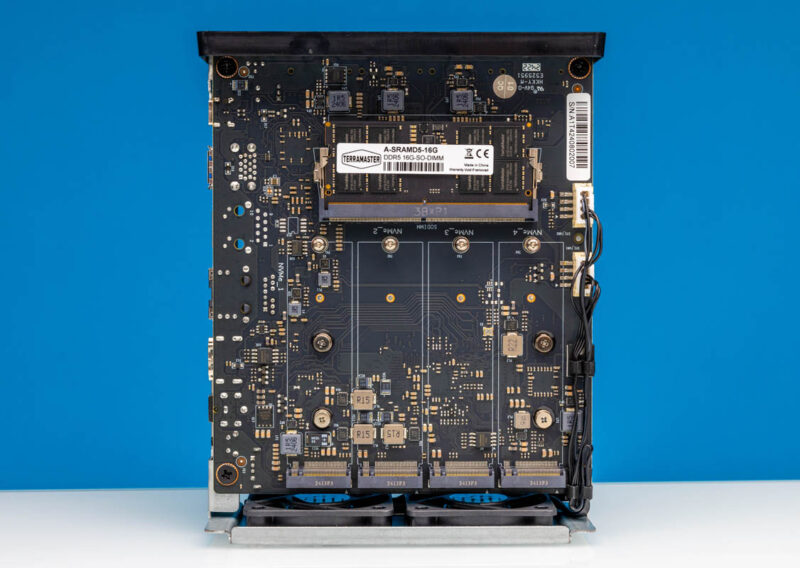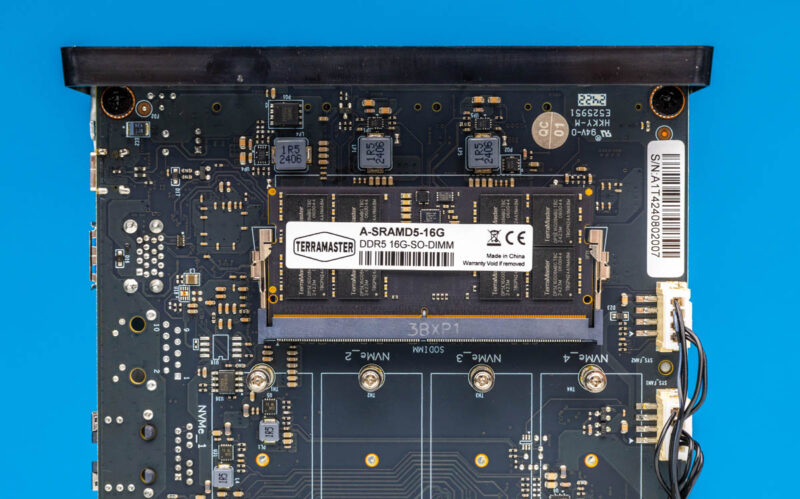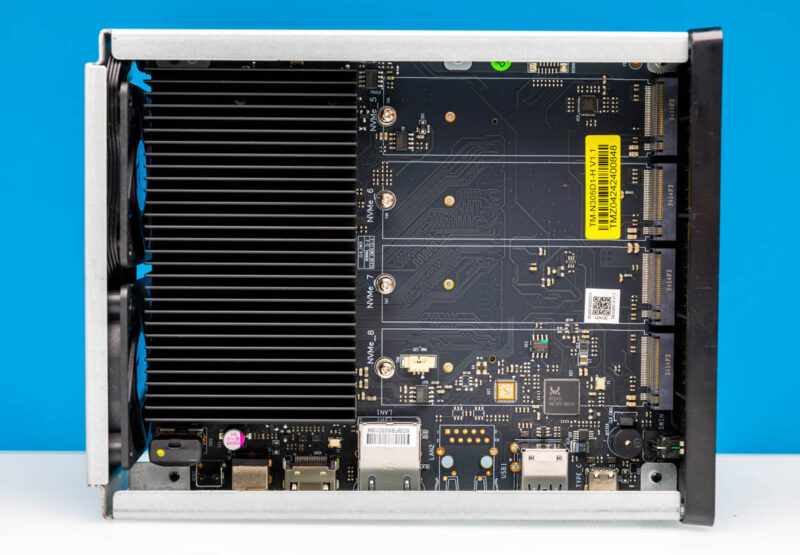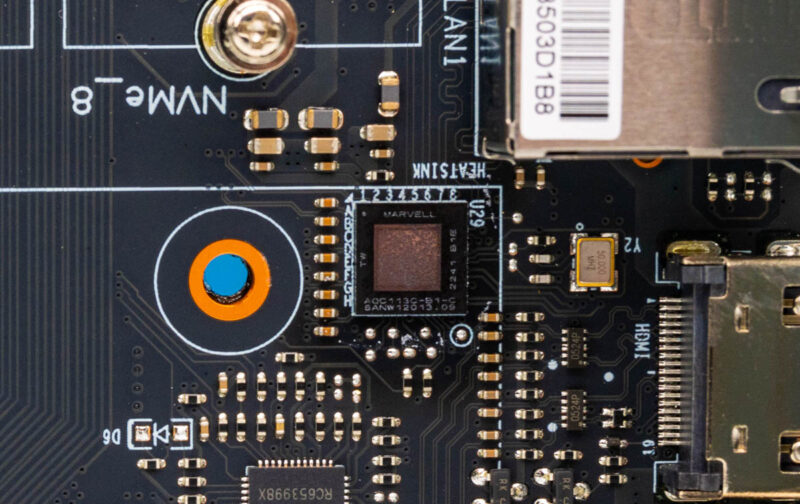TerraMaster F8-SSD Plus NAS Internal Hardware Overview
With the cover removed, we are going to start on the RAM side. Here we can see the SODIMM as well as four M.2 slots.

Here, we have four SSDs installed with their heatsinks. We will have a full look at getting those heatsinks on in the next page.

Included with the Plus model is a 16GB DDR5 SODIMM. The Intel N305 is a single-channel memory solution, and 16GB feels suitable for a NAS like this.

On the backside of the SODIMM, we do not get components that help with cooling. If you wanted to replace a module, this is something to keep in mind.

Under the SODIMM we have our CR2032 battery.

Something else that TerraMaster did that Asustor missed was that the fans are wired to the same assembly as the motherboard. That means you do not need to service the fans. We do, however, wish TerraMaster used standard 4-pin PWM fans instead.

Moving to the other side, we get the big heatsink with our hot components as well as four more M.2 SSD slots.

Something different here is that the M.2 slots are actually on opposite sides and opposite ends of the motherboard.

An area TerraMaster missed on, is not having tool-less installation. Most servers we review today, many of the mini PCs, and even the Asustor Flashstor line have tool-less M.2 retention.
The Realtek RTS5432 is a USB 3.2 Gen2 4-port hub and it is sitting next to the USB 3.2 ports on the motherboard.

Pulling off the heatsink, we can see that TerraMaster applied a LOT of thermal compound. Like, a lot.

The Intel Core i3-N305 8-core processor with an iGPU is underneath that gunk. Not only do we get faster Intel Alder Lake-N cores, but we also get twice the core count of the previous generation. We have shown many times previously that this chip blows away the Intel N5105 and N6005 generation that the Asustor uses.

Some previous reviews and videos online on this unit say that due to the 9-lane PCIe Gen3 complex of the N305, there are no PCIe switches onboard. Here, we can clearly see the ASMedia ASM2806, which is a 6-port PCIe Gen3 switch that is usually found with 1-2 ports connected to the SoC’s PCIe root complex.

The other chip sharing the heatsink is the Marvell AQC113C from the company’s Aquantia acquisition. This is a great low-power 10Gbase-T NIC for a system like this.

Next, let us get to the SSD installation, which was needlessly complex.




Regarding the drive-supplied heat-sinks not fitting: are those heat-sinks out of spec for m.2, taking more space than they should? Or is it that the spacing of the m.2 slots on the NAS motherboard is out of spec, not having as much spacing as they should?
Very nice! I wonder if they will make a U.2 version so we can fill it with eight of those 15.36TB SSDs that are starting to appear second-hand on eBay for around the same price per TB as a new Samsung QVO SATA.
I would have preferred an SFP+ slot.
Would be interesting to see if and how well this would work with trueNAS as the OS.
Can you install truenas?
SFP+ would have been a great step in the right direction.
Can we get power figures without drives? 8xanything is going to vary wildly based on the drives used.
Does it accept power in on the usb-c port? If so that makes it a lot more portable with a resonably capable GaN usb-c brick
I just want something like this with dual sas hba ports that I can attach to a couple home lab hosts.
Oh gee! Flash NAS for the “Gotta Have It Yesterday” generation.
Sory. Nope. No sale here.
A true test would be installing TrueNAS Scale and configuring 8x 4TB SSD drives in RAIDZ2, or similar. Also it’d be nice to see how the GPU performs tasks like transcoding… pretty sure it goes beyond the intended hardware review.
I hope the next version will show 2x 10Gb ports (ideally SFP+) and CPU with more PCIe lanes – such as embedded AMD variant. Intel was always stingy with PCIe lanes.
And also, AMD would provide ECC support… but I feel I’m venturing into higher class of hardware. While doable, it would increase the price and shrink the potential market… probably not going to happen. But I’d buy such an advanced device in a second.
What’s the point of using nvme ssds with over 3500mbs writing at a quarter of their speed?
To not have moving parts, be quiet, low power, and portable.
what would be a reasonably reliable and priced UPS for this device. PSU is 72 W on this device and Specs say, “Power consumption 45.0 W (Fully loaded Seagate 2TB M.2 SSDs in read/write state).” UPS compatibility chart on Terra-Master site has dozens of out-dated, no-longer available listed UPSs on sheet. Noob here and would like some UPS protection advice for this new toy.
~9W rated power (SN850X 1TB 3.3v, 2.8A) x 8 = 72W
I don’t feel very comfortable with a 72W power supply for the whole system.